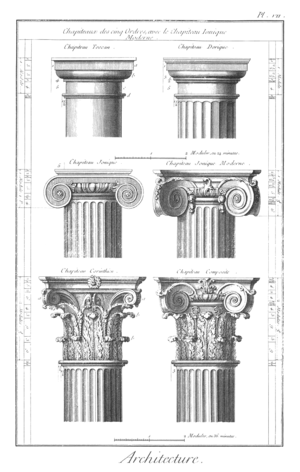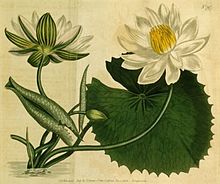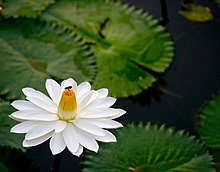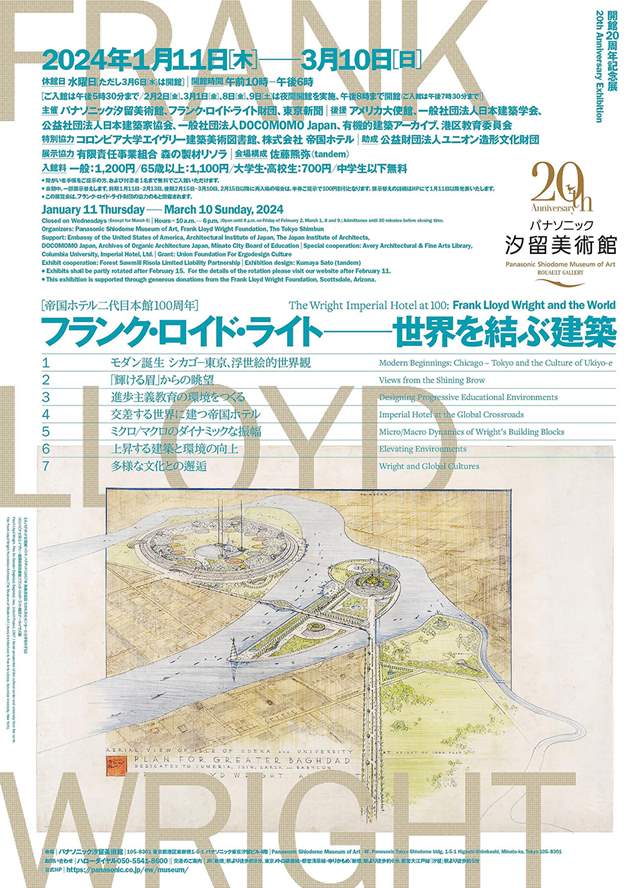弗蘭克·勞埃德·賴特(Frank Lloyd Wright,1867-1959),現代美國建築大師。 賴特以考夫曼故居和古根海姆博物館的作品而聞名,他是一位與日本有著深厚淵源的建築師,曾參與帝國酒店(現已部分搬遷並保存在明治村博物館)和自由學園的第二座主樓,也是浮世繪的狂熱愛好者。
2012年,弗蘭克·勞埃德·賴特基金會(Frank Lloyd Wright Foundation)向紐約現代藝術博物館(Museum of Modern Art)和哥倫比亞大學艾弗里建築與藝術圖書館(Avery Architecture and Art Library)轉移了包括圖紙在內的50,000多份資料。 基於這項研究的結果,本次展覽由大島健(華盛頓大學教授)和詹妮弗·格雷(弗蘭克·勞埃德·賴特基金會副會長兼塔里埃森研究所所長)在日本和美國共同策劃,揭示了賴特在與以帝國酒店為中心的多元文化互動方面一直處於領先地位的開創性活動。
請欣賞一些精美而精彩的圖畫。 賴特的全球視野一直活躍於全球,應該與當今21世紀的挑戰產生共鳴,並作為未來的建議。
法蘭克.洛伊.萊特基金會(The Frank Lloyd Wright Foundation)於2012年將五萬多件資料轉移到紐約現代美術館和哥倫比亞大學艾弗里建築與美術圖書館(Avery Architectural And Fine Arts Library),其中涵蓋建築、藝術、設計、造景、教育、技術革新、都市計畫等各種調查研究與設計圖,是凝聚這位世紀建築巨匠傲人的廣闊視野和卓越智慧的紀錄。以這批資料為基礎,由日本和美國聯合策畫在東京松下汐留美術館パナソニック汐留美術館 Panasonic Shiodome Museum of Art
舉辦的「法蘭克.洛伊.萊特:連結世界的建築」,以介紹竣工一百週年的帝國酒店第二代本館為主軸,展現萊特積極參與多元文化互動交流並不斷開展各類建設活動的前衛者姿態。(撰文.攝影/吳曉芳)(節選自《藝術家》586期,2024年3月號)
Avery Architectural and Fine Arts Library, the world's largest architecture library, is located in Avery Hall on the Morningside Heights campus of Columbia University in New York City.
Wikipedia
圖說:「法蘭克.洛伊.萊特:連結世界的建築」展場一景

《藝術家》586期選購連結請見留言處

———————————————————
143) Frank Lloyd Wright(1867–1959) 的建築美夢 (千分之一作品......) :Hollyhock House(蜀葵居)。日本浮世繪..... 古埃及古希臘將其所愛引入建築.....Hollyhock House也是一;與羅時瑋兄的短暫筆談 (202208.27)
https://www.facebook.com/hanching.chung/videos/803389254009755
143) Frank Lloyd Wright(1867–1959) 的建築美夢 (千分之一作品......) :Hollyhock House(蜀葵居)。日本浮世繪..... 古埃及古希臘將其所愛引入建築.....Hollyhock House也是一;與羅時瑋兄的短暫筆談 (202208.27)
https://www.facebook.com/hanching.chung/videos/803389254009755
昨天的心得:萊特是日本浮世繪專家,有論文,其中指出古埃及古希臘將其所愛引入建築.....他的Hollyhock House也一例
Frank Lloyd Wright and Japan - Center for East Asian Studies
https://eastasia.wisc.edu › uploads › sites › 2021/05PDF
由 K Nute 著作 · 2021 · 被引用 180 次 — The lotus gained thus imperishable significance; for the life -principle in the flower is translated— transmuted to terms of building stone to idealize a
"最初屋主 Aline Barnsdall 邀請萊特建造一座「瑪雅風情」的別墅,並在建築裝飾上大量使用喜愛的 Hollyhock(蜀葵)元素,如今建築作為 Barnsdall 藝術公園的核心,也是聯合國教科文組織指定的世界遺產。"
科林斯柱式[編輯]
希臘科林斯柱式(Corinthian Order)的比例比愛奧尼柱更為纖細,柱頭是用毛莨葉(Acanthus)作裝飾,形似盛滿花草的花籃。相對於愛奧尼柱式,科林斯柱式的裝飾性更強,但是在古希臘的應用並不廣泛,雅典的宙斯神廟(Temple of Zeus)採用的是科林斯柱式。

Encyclopédie 第18冊:建築柱式的
雕版印刷 萊特與 歐姬芙 台中:好讀,2005
小說The Fountainhead (重慶有中譯本)究竟採用Frank Lloyd Wright (1867–1959) 或者Walter Gropius (18 May 1883 – 5 July 1969) 當原型?
Asked for his occupation in a court of law,
Frank Lloyd Wright (1867–1959) replied ‘The world’s greatest architect’. His wife remonstrated with him. ‘I had no choice, Olgivanna’, he told her, ‘I was under oath.’
The cocksure Wright was a master of the one-line quip. He told a client who phoned to complain of rain leaking from the roof of her new house onto the dining table where she was sitting to ‘move the chair’. Thinking of Mies, he said, ‘Less is only more where more is no good’. On seeing his tall assistant, William Wesley Peters, inside one of his latest and rather low-ceilinged houses, he barked, ‘Sit down, Wes, you’re ruining the scale of my architecture’. Of himself, this very original American architect bragged, ‘Early in life I had to choose between honest arrogance and hypocritical humility. I chose the former and have seen no reason to change.’
Wright lived a roller-coaster life. He abandoned his first wife, Kitty, and five children and fled to Europe with his mistress and client, Mamah Cheney. On their return to the
US, Mamah and her children were murdered at his home, Taliesin, which burned down (and Wright rebuilt) twice. His autobiography, a best seller, was the inspiration for Ayn Rand’s novel
The Fountainhead, made into a dramatic film with Gary Cooper in the lead role.
Wright’s architecture could be something of a fairground ride, too. When questioned over the heights of the galleries in his sensational Solomon R. Guggenheim Museum on Fifth Avenue, he said, ‘Cut the paintings in half ’. ‘A doctor’, he joked, more than half-seriously, ‘can bury his mistakes, but an architect can only advise his clients to plant vines.’
Designed as a weekend retreat for the wealthy Pittsburgh store-owners Edgar and Liliane Kaufmann,
Fallingwater (1939) was built on an outcrop of rock over a waterfall at Bear Run, Pennsylvania. Its three floors took the form of ambitious 19-metre (62-foot) concrete cantilevers, thrust 5 metres (16 1⁄2 feet) over the fast-falling water from a rock where the Kaufmanns had long enjoyed picnics. This was a dramatic and costly move, yet
Fallingwater was a truly beautiful design and the Kaufmanns could well afford the $155,000—a huge sum at the time; the budget had been $30,000—they paid for the house of their dreams.
In 1997, scaffolding was put in place to stop
Fallingwater falling down. Four years later, a repair programme was announced. It would cost $11.5 million to right the wrongs of those daring cantilevers. Robert Silman, a structural engineer from New York who had already worked on seven Wright houses, planned the work. ‘This doesn’t diminish the architectural brilliance of his buildings’, he said. ‘One after the other, they are absolutely breathtaking.’ And this is why,
Fallingwater – expensive to build and maintain – will never be short of funds. Wright’s architecture could indeed be a liability, yet those who choose to live in Wright homes love them, and, as experience tells us, the price of true love can be very costly indeed.

White lotus decorations on a frieze at a palace in
Amarna (1352–1336 BC) The
ancient Egyptians cultivated the white lotus in ponds and marshes.
This flower often appears in ancient Egyptian decorations. They believed that the lotus flower gave them strength and power; remains of the flower have been found in the burial tomb of
Ramesses II. Egyptian tomb paintings from around 1500 BC provide some of the earliest physical evidence of
ornamental horticulture and landscape design; they depict lotus ponds surrounded by symmetrical rows of acacias and palms. In Egyptian mythology
Horus was occasionally shown in art as a naked boy with a finger in his mouth sitting on a lotus with his mother. The lotus was one of the two earliest Egyptian
capitals motifs, the topmost members of a column. At that time, the motifs of importance are those based on the lotus and papyrus plants respectively, and these, with the palm tree capital, were the chief types employed by the Egyptians, until under the Ptolemies in the 3rd to 1st centuries BC, various other river plants were also employed, and the conventional lotus capital went through various modifications. Women often wore amulets during childbirth, which depicted
Heqet as a frog, sitting in a lotus.
The number 1,000 in ancient Egyptian numerals is represented by the symbol of the white lotus. The related hieroglyph is:
The ancient Egyptians also extracted perfume from this flower. They also used the white lotus in funerary garlands, temple offerings and female adornment.
The white lotus is a candidate for the plant eaten by the Lotophagi of Homer's Odyssey.
Nymphaea lotus, the white Egyptian lotus,[3] tiger lotus, white lotus or Egyptian white water-lily, is a flowering plant of the family Nymphaeaceae.
Distribution[edit]
It grows in various parts of East Africa and Southeast Asia. The Nymphaea lotus var. thermalis is a tertiary relict variety, endemic to the thermal waters of Europe, for example the Peţa River in Romania or the Hévíz lake in Hungary .[citation needed]
Cultivation[edit]
It was introduced into western cultivation in 1802 by Loddiges Nursery. Eduard Ortgies crossed Nymphaea lotus (N. dentata) with Nymphaea pubescens (N. rubra) to produce the first Nymphaea hybrid, illustrated in Flore des serres 8 t. 775, 776 under the name Nymphaea ortgiesiano-rubra. It is a popular ornamental aquatic plant in Venezuela.[citation needed]
Description[edit]

Nymphaea lotus in Southern India.







沒有留言:
張貼留言